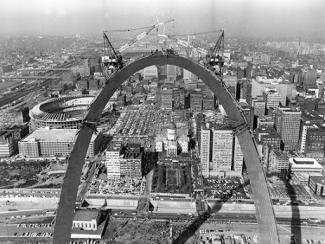
St. Louis is often called the “Gateway to the West.” The Gateway Arch doubles down on this expression of westward expansion as the federal government originally erected it in the early 1960s to commemorate President Thomas Jefferson’s Louisiana Purchase of 1803 and the genocide of Native Americans. But that’s only the beginning of the history of the famous landmark.
The Gateway was built on Mill Creek Valley, a Black neighborhood. To clear land for construction, more than 20,000 residents, 95% of whom were Black, were displaced. Further, nearly 300 Black businesses were destroyed.
The Black people of St. Louis refused to be displaced from their homes. Protests of both the Gateway’’s construction and the lack of Black contractors assigned to the project erupted in 1964. Black residents fought relentlessly.
James Baldwin said it best: “Urban renewal…means negro removal.” Of the $120 billion worth of new government-subsidized housing between 1934 and 1962, less than 2% went to nonwhite families. Ultimately, the city of St. Louis took Black people’s land and raised a symbol of hate on it.
The Black community in St. Louis didn't submit to the Gateway’s construction. They protested and fought back even though the odds were stacked against them. Liberation won’t be easily won, but no matter what we must use our voices to speak out and make our stories known.